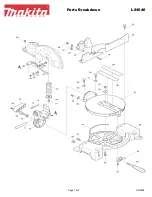
-21-
5.2 Switching on and off
Switching on:
First of all, unlock the switch-on
lock by pressing the locking lever 8 (Fig. 4).
Then, keeping the locking lever depressed,
activate the gearshift lever 7.
As this is a switch without locking device, the
machine will only run for as long as this gearshift
lever is pressed.
The built-in electronic system provides for jerk-free
acceleration when the machine is switched on and
under load readjusts the speed to the fixed setting.
In addition, this electronic system adjusts the motor
down in case of overload, i.e. the saw blade will stop.
Switch the machine off then. Then switch the
machine on again and continue sawing at a reduced
feed speed.
WIth the setting wheel 22 (Fig. 4) you can steplessly
adjust the saw speed between 1400 and 1700 rpm.
Switching off:
To switch off, release the switch
trigger 7. The built-in automatic brake limits the
saw blade slowing time to approx. 5 s. The
switch-on lock automatically takes effect again
and secures the portable circular saw against
accidental switch-on.
5.3 Cutting depth adjustment
The cutting depth is continuously variable between 85
and 165 mm (3 3/8 and 6 1/2 in.).
Proceed as follows to adjust it:
First of all, release the clamping lever 10 (Fig. 5)
by turning it counter clockwise.
You can now adjust the cutting depth by turning
the handle 9.
The set depth can be read off the scale ring 21
(Fig. 5). The inscription on the gearbox case
serves as indicator in this regard.
After adjusting, tighten the clamping lever again.
Always set the cutting depth
approx. 2 to 5 mm (1/16 to 3/16 in.)
larger than the material thickness
to be cut.
5.4 Setting for bevel cuts
For bevel cuts, the saw unit can be set to any angle
between 0 and 60°.
Bring the machine into a stable position and
support it such that it is possible to tilt the saw
unit.
Then release the two wing screws 16 (Fig. 2
and Fig. 4), tilt the unit to the desired angle
shown on the indicator 17 (Fig. 2) on scale 18 at
the segment for tilting.
Afterwards, retighten both wing screws 16 (Fig.
2 and Fig. 4).
5.5 Sawing according to tracings
The base plate is on the inside equipped with a
tracing edge that applies both to straight cuts and for
all angles of inclination. This tracing edge
corresponds to the saw blade's inside. For bevel cuts,
the tracing can be viewed through the opening on the
left-hand side of the upper saw guard (arrow, Fig. 5).
For sawing, hold the machine by both its
handles 11 (Fig. 4) and 12 (Fig. 2) and place the
front part of the base plate onto the workpiece.
To facilitate the first cut, the retractable saw
guard 1 (Fig. 1) can be opened by pressing the
lever 13 (Fig. 5) that is arranged directly next to
the front handle.
When this lever is released, the saw guard closes
automatically.
Switch on the portable circular saw (see chapter
5.2) and slide the machine evenly forward in the
direction of the cut.
Once you have executed the cut, immediately
switch off the saw by releasing the gearshift
lever 7 (Fig. 4).
5.6 Sawing with parallel guide fence
The portable circular saw is equipped with a parallel
guide fence on both sides, so that it is possible to saw
on both sides of the machine parallel to an already
existing edge without retooling. The cutting range on
the right-hand side amounts to 140 mm (5 1/2 in.) and
on the left-hand side to 320 mm (12 5/8 in.).
In order to adjust the cutting width, unscrew the
wing screws 14 (Fig. 4) and move the guide
fence accordingly. Afterwards, retighten the
wing screws 14.






























